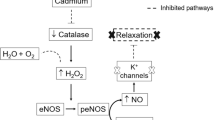Abstract
The results of experiments designed to show that inhibition of nitric oxide production in rats exposed to low lead levels increases vascular resistance, decreases renal blood flow and glomerular function, and enhances oxidative stress. Forty-five adult male Sprague-Dawley rats were divided into four groups. Group A was used as controls and consisted of rats that received no treatment; group B acted as NO-inhibited controls by receiving l-NAME (N G-nitro-l-arginine methyl ester) as the NO inhibitor; group C was injected intraperitoneally with 8 mg/kg lead acetate for 2 wk; and group D receiving lead acetate plus l-NAME.
Compared to healthy controls, significant elevation of the mean (p<0.01), systolic (p<0.04), and diastolic (p<0.01) blood pressures was found in the lead-treated rats. The renal blood flow was 1550±468 blood per unit (bpu) in the controls, 488±220 bpu in the l-NAME controls, 1050±458 bpu in the lead-treated group, and 878±487 bpu in the Pb plus l-NAME group.
Low-level lead exposure did not change the urinary flow rate, creatinine clearance, and the creatinine, potassium, phosphorus, glucose, and protein excretion in 24-h urine. In the lead plus NO-inhibited rats, a significant decrease in sodium ion excretion was observed (p<0.01). The NO levels of the lead exposed, l-NAME-treated controls, and l-NAME plus lead-exposed groups are significantly lower compared to untreated control:: p<0.002, p<0.001, and p<0.01, respectively. When compared to untreated controls, the plasma malondialdehyde levels were not significantly different in the lead exposed, lead plus l-NAME, and l-NAME control groups.
These results suggest that lead-induced hypertension might be related to a decrease of NO and consequent vasoconstriction, rather than to a decrease of renal blood flow or to decreases in renal sodium.
Similar content being viewed by others
References
W. R. Harlan, The relationship of blood lead levels to blood pressure in the us population, Environ. Health Perspect. 78, 9–13 (1988).
H. C. Gonick, Y. Ding, S. C. Bandy, Z. Ni, and N. D. Varizi, Lead-induced hypertension: interplay of nitric oxide and reactive oxygen species, Hypertension, 30, 1487–1492 (1997).
N. D. Vaziri, Y. Ding, Z. Ni, and H. C. Gonick, Altered nitric oxide metabolism and increased oxygen free radical activity in lead-induced hypertension: effect of lazaroid therapy, Kidney Int., 52, 1042–1046 (1997).
N. D. Vaziri, Y. Ding, Z. Ni, and H. C. Gonick, Nitric oxide synthase expression in course endothelial cells; role of superoxide, Hypertension 34, 558–562 (1999).
N. D. Vaziri, K. Liang, and Y. Ding, Increased nitric oxide inactivation by reactive oxygen species in lead-induced hypertension, Kidney Int. 56, 1492–1498 (1999b).
D. A. Tsao, H. S. Yu, J. T. Cheng, C. K. Ho, and H. R. Chang, The change of beta-adrenergic system in lead-induced hypertension, Toxicol. Appl. Pharmacol., 164, 127–133 (2000).
M. Carmignani, P. Buscolo, A. Poma, and A. R. Volpe, Kininergic system and arterial hypertension following chronic exposure to inorganic lead, Immunopharmacology 44, 105–110 (1999).
F. Khalil-Manesh, H. D. Gonick, E. W. S. Weiler, B. Prins, M. A. Weber, and R. E. Purdy, Lead induced hypertension possibe role of endothelial factors, Am. J. Hypertens, 6, 723–729 (1993).
S. W. Watts, S. Chai, and R. C. Webb, Lead acetate-induced contratcion in rabit, mesenteric artery: interaction with calcium and protein kinase C, Toxicology, 99, 55–56 (1995).
H. C. Gonick, Y. Ding, and N D. Vaziri, Effect of low lead exposure on eicosanoid excretion in rats, Prostaglandins Other Lipid Mediat. 55, 77–82 (1998).
M. Carmignani, P. Boscolo, A. Poma, and A. R. Volpe, Catchomamine and nitric oxide systems as targets of chronic lead exposure in inducing selective functional impairmen, Life Sci. 68, 401–415 (2000).
Y. Ding, N. D. Vaziri, and H. C. Gonick, Lead-induced hypertension. II. Response to seguential of l-arginine, superoxide dismutase and nitroprusside, Environ. Res., 76, 107–113 (1998).
L. T. Dijkhorst-Oei and H. A. Koomans, Effects of a nitric oxide synthesis inhibitor on renal sodium handling and diluting capacity in humans, Nephrol. Dial. Transplant. 13, 587–593 (1998).
S. Harada, S. Tokunaga, M. Momohara, et al., Inhibition of nitric oxide formation in the nucleus tractus solitarius increases renal sympathetic nerve activity in rabbits, Circ. Res. 72, 511–516 (1993).
B. Halliwell, What nitrates tyrosine? Is nitrotyrosine specific as a biomarker of peroxynitrite formation in vivo? FEBS Lett. 411, 157–160 (1997).
H. H. Draper and M. Hadley, Malondialdehyde determination as on index of lipid peroxidation. Methods Enzymol. 186, 421–431 (1990).
K. Arto and T. Sandra, The calcium dependent nitric oxide production of human vascular endothelial cell in preeclamsia, Am. J. Obstet. Gynecol. 174, 1056–1060 (1996).
V. D. Vaziri, Y. Ding, and Z. Ni, Compensatory upregulation of nitric oxide synthase isoforms in lead induced hypertension; reversal by a superoxide dismutase-imetic drug, J. Pharmacol. Exp. Ther., 298, 679–685 (2001).
R. Kim, D. Sparrow, S. Weiss, C. Wager, and H. Hu, A longitudinal study of low-level exposure and impairment of renal function. The Normative Aging Study, JAMA 275, 1177–1781 (1996).
J. Staessen, Low-level lead exposure, renal function and blood pressure, Verh. K. Acad. Genesskd. Belg. 57(6), 527–574 (1995).
Y. Ding, H. C. Gonick, N. D. Vaziri, K. Liang, and L. Wei, Lead induced hypertension. III Increased hidroxyl radical production, Am. J. Hypertens. 14, 169–173 (2001).
Y. Ding, C. Harvey, H. C. Gonick, and N. D. Vazin, Lead promotes hydroxyl radical generation and lipid peroxidation in caltured aortic endothelial cell, Am. J. Hypertens, 13, 552–555 (2000).
N. Dursun and A. Tutu, Chronic occupational lead exposure and thyroid function, J. Trace Elements Exp. Med., 12(1), 45–49 (1999).
N. Dursun and R. Saraymen, Chronic occupational lead exposure and testicular function, Trace. Elements Electrolytes, 54(2), 64–68 (2001).
N. Dursun, P. Dogan, and H. Donmez, Plasma and erythrocyte lipid peroxide levels in workers with occupational exposure to lead, Biol. Trace Element Res 82(1–3), 29–34 (2001).
Author information
Authors and Affiliations
Rights and permissions
About this article
Cite this article
Dursun, N., Arifoglu, C., Süer, C. et al. Blood pressure relationship to nitric oxide, lipid peroxidation, renal function, and renal blood flow in rats exposed to low lead levels. Biol Trace Elem Res 104, 141–149 (2005). https://doi.org/10.1385/BTER:104:2:141
Received:
Revised:
Accepted:
Issue Date:
DOI: https://doi.org/10.1385/BTER:104:2:141




